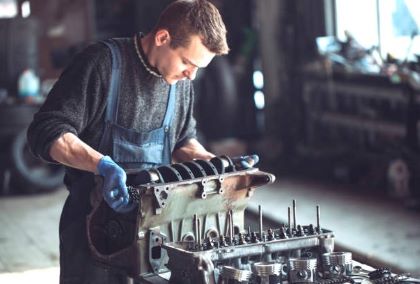
Automotive and diesel mechanics inspect, repair, and overhaul cars, buses and trucks. Although service technicians work on traditional mechanical systems, such as engines, transmissions, and drivebelts, they also must be familiar with a growing number of electronic systems. Braking, transmission, and steering systems are increasingly controlled by computer chips. Additionally, fuel injection and engine timing systems rely on microprocessors to maximize fuel efficiency and minimize harmful emissions.
Further, diesel service technicians and mechanics may work on a vehicle's electrical system, make major engine repairs, or retrofit engines with emission control systems to comply with pollution regulations. For example, they may use an oscilloscope to observe the signals produced by electronic components. After identifying malfunctioning equipment, service technicians repair and recalibrate components such as hydraulic pumps and spark plugs. Service technicians use many different tools, including power tools such as pneumatic wrenches, welding torches, and engine hoists. In fact, experienced workers literally may have several thousand dollars invested in their tool collection.
Completing a vocational training program in diesel technology or heavy equipment mechanics is increasingly considered the best preparation for some entry-level positions. These programs cover diagnostic techniques, electronics, and related subjects. Programs may last 1 to 2 years and lead to a certificate. Other programs, which lead to associate's degrees, generally take 2 years to complete. These degree programs mix classroom instruction with hands-on training, and include courses on diesel technology, repair techniques, performance optimization, and equipment tooling.
Students also learn how to interpret technical manual diagrams and electronic diagnostic reports. Automotive technicians receive extensive on-the-job training, and trainees are assigned basic tasks, such as cleaning parts, checking fuel and oil levels, and driving vehicles in and out of the shop. After they learn routine maintenance, trainees move on to vehicle inspection and diagnostics, at which point a trainee is usually considered a journey-level mechanic. Employers often send experienced mechanics to special training classes conducted by manufacturers and vendors to learn about the latest diesel technology.
Certification programs enable students to learn new skills and demonstrate their expertise to potential employers. To earn certifications, candidates often complete training programs followed by a written or oral exam.
| Certification Level | Skills Required |
| Apprentice Mechanic |
|
| Journeyman Mechanic |
|
| Master Mechanic |
|
Certification from the National Institute for Automotive Service Excellence (ASE) is the standard credential for diesel and other automotive service technicians. Diesel technicians may be certified in drivetrains, electronic systems, and preventative maintenance and inspection.
To earn certification, auto mechanics must have 2 years of work experience and pass one or more ASE exams. To remain certified, diesel technicians must pass a recertification exam every 5 years. Many diesel mechanics are required to have a commercial driver's license so that they may test-drive buses and large trucks.
Diesel engines are the most versatile IC Engines. With help of animation working of Diesel engine is elaborately explained in this video. Here the basic construction of diesel engine, its working and mechanical design aspects are covered.
The working of an automatic transmission is best understood with help of a 2D animation. This video demonstrates working of Allison 6 speed transmission in a step by step logical manner. Working of reverse gear is also explained here.
What is happening inside a car when you press the clutch pedal? Why do you need to press the clutch pedal before you shift gears with a manual transmission? This video gives you logical answers to these questions.
Alternators are also referred as synchronous generators. Construction details of the generator, functions of slip rings, armature coils, Automatic Voltage regulator (AVR) and pole core are explained.
Ask yourself if you can see yourself being a mechanic, working with complex equipment, which can be challenging at times. While classes and internships will prepare you well, certain innate qualities that you bring to bear will help you succeed.
Attending college offers benefits beyond academic learning. Students are exposed to diverse perspectives that challenge their thinking. This fosters problem-solving and communication. College is also about social skills. Whether through student organizations or sports teams, students develop leadership skills and build lasting friendships.
This website is not affiliated with any educational institution, and all trademarks are the exclusive property of the respective owners. All copyrighted works on this website are offered for educational purposes only, governed by the four-factor rule, section 107 of the Copyright Act. CampusInspector.com is the work of a group of students in Bangkok, using data from the US Department of Education, Postsecondary Education Data System (IPEDS). If any information is incorrect, please contact us with updates.